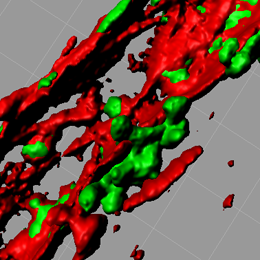Entangled in the endothelium

LMU researchers have uncovered the underlying cause of a rare type of immunodeficiency syndrome, which severely impairs their ability to fight infections.
A functional defect in the protein kinase MST1 has been associated with a rare human immunodeficiency syndrome, which is characterized by recurrent bouts of inflammation induced by invasive fungi, bacteria and viruses. An international team of researchers, led by Professor Markus Sperandio of the Walter Brendel Center for Experimental Medicine at LMU Munich, has now linked this defect to the inhibition of a specific molecular process. In a paper which appears in the Journal of Clinical Investigation, he and his colleagues report that so-called neutrophilic granulocytes – a particular class of immune cells – are functionally impaired in the absence of MST1.
Neutrophilic granulocytes are essential for the initial response to infection and inflammation, which is mediated by the so-called innate immune system. "These cells are the first "rapid-response" units to arrive at the scene of action, and they bring a whole arsenal of defense mechanisms with them," Sperandio explains. To reach the site of infection, they must leave the bloodstream by squeezing through so-called endothelial cells that line the inner blood-vessel wall. It now turns out that mouse neutrophils which lack the gene for MST1 don't get very far. "In the absence of MST1, neutrophilic granulocytes are unable to leave the vasculature and cannot reach the tissue sites where they are needed. They can penetrate through the endothelial cell layer, but they get stuck then at the next barrier – the so-called basement membrane," Sperandio explains. He and his colleagues characterized the defect in a study carried out as part of the work of the DFG-funded Collaborative Research Center on Trafficking of Immune Cells in Inflammation, Development and Disease (SFB 914).
In functional neutrophils, intracellular membrane vesicles transport specific proteins to the cell surface, which together recognize and potentially degrade components of the basement membrane, allowing the cells to migrate through it. If the MST1 enzyme is missing, however, trafficking of the vesicles to the cell surface fails to take place. This is probably because, as the team has also shown, MST1 normally interacts with a specific partner protein that regulates vesicle transport. "Our study demonstrates that MST1 is crucial both for vesicle transport and for the ability of neutrophils to migrate through the vasculature," Sperandio concludes. The new findings also explain why children who carry mutations in the MST1 gene (which was identified in 2012 by a team led by Professor Christoph Klein, Director of Dr. von Hauner's Children's Hospital at the LMU Medical Center) become so ill. Lacking the ability to mobilize their neutrophils, they are unable to mount an effective immune response to invasive pathogens.
More information: Angela R.M. Kurz et al. MST1-dependent vesicle trafficking regulates neutrophil transmigration through the vascular basement membrane, Journal of Clinical Investigation (2016). DOI: 10.1172/JCI87043
















